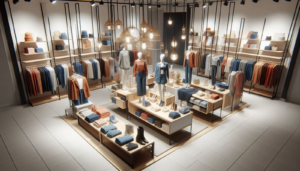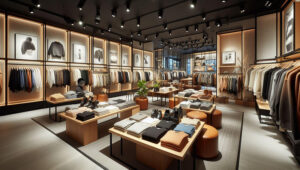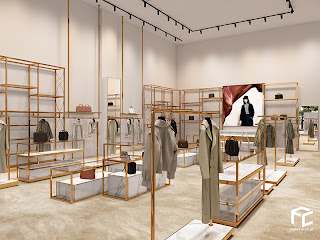[ad_1]
In the world of retail, the visual appeal of your store can make a significant difference in attracting customers and driving sales. For clothing shops, where the competition is fierce, the right clothing store display fixtures and fittings not only enhance the aesthetic of your merchandise but also create an inviting atmosphere that can turn passersby into patrons. This article delves into the art of selecting the perfect fixtures for your clothing store, ensuring that every hanger, shelf, and mannequin works in harmony to showcase your fashion pieces.
Understanding Your Store’s Brand and Theme
Before diving into the world of display fixtures, take a step back to understand your store’s brand identity and theme. Are you targeting a niche market with high-end luxury apparel, or are you catering to a younger, more casual demographic? Your fixtures should align with your brand image and resonate with your target audience.

Spatial Analysis and Store Layout
Every clothing store is unique, so evaluating the layout and available space is crucial for optimizing display fixtures. Consider factors like foot traffic patterns, high-visibility areas, and potential obstacles that may affect customer flow. Understanding the store layout is essential—it serves as the foundation for display fixtures. Whether it’s a spacious boutique or a cozy corner store, your layout should guide customers from the entrance to the checkout counter. It should be intuitive, allowing customers to flow through the space, discovering new products with each turn.
Types of Display Fixtures
Wall Units and Shelving: Wall units and shelving are the backbone of most clothing stores. They offer a versatile way to display a variety of items and can be easily adjusted to accommodate changing inventory. When selecting these, consider the weight they’ll need to support and the flexibility for reconfiguration.
Racks and Hangers: Racks come in various forms, from circular to straight, and each serves a different purpose. Circular racks are great for sales and clearance items, while straight racks present new arrivals and featured collections. Hangers, too, play a subtle yet significant role. Choose hangers that match the store’s aesthetic and keep clothing wrinkle-free.
Mannequins: Mannequins are silent salespeople, showcasing how clothes look when worn. They should reflect your target demographic in terms of body type and style. Position them strategically to create focal points and highlight key pieces.
Selecting Fixtures for Your Brand
Your brand’s identity should resonate through your choice of fixtures. A high-end boutique might opt for sleek, minimalist designs, while a vintage store could go for rustic, wooden fixtures. Think about the message you want to convey and select fixtures that align with your brand’s image and values.
Choosing the Right Materials
When selecting display fixtures, consider the materials that best complement your store’s aesthetic and durability requirements. Wood exudes warmth and sophistication, while metal offers a sleek and modern look. Glass fixtures add an element of transparency and elegance, but they may require more maintenance to keep clean.
Lighting Considerations
Proper lighting can make all the difference in highlighting your products and creating an inviting atmosphere. Experiment with different lighting techniques, such as spotlights and ambient lighting, to accentuate key pieces and enhance the overall ambiance of your store.

Placement and Arrangement
Strategic placement of display fixtures is essential for maximizing visibility and encouraging browsing. Create focal points throughout your store to draw customers in and guide them through different sections. Pay attention to sightlines and avoid cluttering aisles with overcrowded displays.
Flexibility and Adaptability
In a dynamic retail environment, flexibility is key. Choose display fixtures that can easily adapt to changes in inventory and seasonal promotions. Modular fixtures offer versatility and allow you to reconfigure your store layout as needed, while fixed installations provide stability and durability.
Budgeting and Cost Considerations
While it’s tempting to splurge on fancy fixtures, it’s essential to strike a balance between quality and affordability. Consider the long-term investment value of your fixtures and prioritize durability and functionality over aesthetics alone. Remember that your display fixtures are an investment in your store’s success.
Sustainability and Eco-Friendly Options
As consumers become more environmentally conscious, there’s a growing demand for sustainable and eco-friendly retail practices. Explore options such as recycled materials, energy-efficient lighting, and reusable display fixtures to minimize your store’s environmental footprint and appeal to eco-conscious shoppers.
Incorporating Technology
Embrace the digital age by integrating technology into your display fixtures. Digital signage and interactive displays can engage customers and provide valuable information about your products. Consider implementing features such as QR codes and augmented reality experiences to bridge the gap between online and offline shopping.
Maintaining Consistency
Consistency is key to creating a cohesive shopping experience. Ensure that your display fixtures align with your store’s overall aesthetic and branding guidelines. Consistent use of colors, materials, and signage will reinforce your brand identity and help build customer trust and loyalty.
Customer Engagement
Encourage customer interaction with your display fixtures by incorporating elements that spark curiosity and invite exploration. Interactive displays, product demonstrations, and hands-on experiences can captivate shoppers and encourage them to spend more time in your store.
Case Studies and Examples
Drawing inspiration from successful retailers can provide valuable insights into effective display strategies. Study case studies and examples from renowned clothing shops to glean best practices and innovative ideas for your own store.
Practical Considerations
While aesthetics are important, practicality is paramount. Consider the durability of materials, ease of maintenance, and the flexibility of fixtures. Budgeting is also a key factor; invest in quality where it counts, but don’t overlook affordable options that offer good value for money.
Trends in Retail Design
Staying abreast of retail clothing store interior design trends can give your store a competitive edge. Interactive displays, sustainable materials, and modular systems are currently in vogue. Incorporate these trends thoughtfully to keep your store looking fresh and modern.
Conclusion
Effective display fixtures are essential for creating an inviting atmosphere and showcasing your merchandise in the best possible light. By understanding your store’s brand and theme, analyzing your space, and selecting the right fixtures and fittings, you can create a memorable shopping experience that keeps customers coming back for more.
## **FAQs (Frequently Asked Questions)**
- Q: How do I determine the appropriate size and quantity of display fixtures for my clothing shop?
– A: Start by assessing your store’s layout and available space, then consider factors such as foot traffic patterns and the volume of inventory you plan to display. Experiment with different configurations to find the optimal balance between visibility and functionality.
- Q: What are some cost-effective alternatives to traditional display fixtures?
– A: Consider DIY options using affordable materials such as PVC pipes, wooden crates, or repurposed furniture. Get creative and think outside the box to find unique solutions that fit your budget without compromising on style.
- Q: How often should I update my display fixtures to keep up with changing trends?
A: It’s essential to stay current with evolving trends to keep your store fresh and engaging for customers. Consider updating your display fixtures seasonally or whenever you introduce new collections or promotions. Regularly refreshing your displays will help maintain customer interest and drive sales.
[ad_2]
Source link
